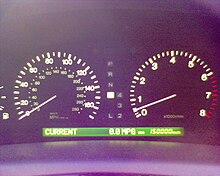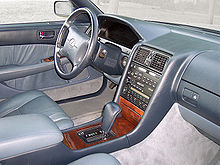Lexus UCF10
| Lexus | |
|---|---|
|
Lexus LS 400 (1989-1994)
|
|
| LS | |
| Production period: | 1989-1994 |
| Class : | Upper class |
| Body versions : | limousine |
| Engines: |
Otto engine : 4.0 liters (190 kW) |
| Length: | 4996-5005 mm |
| Width: | 1821-1829 mm |
| Height: | 1405-1415 mm |
| Wheelbase : | 2814 mm |
| Empty weight : | 1705-1750 kg |
| successor | Lexus UCF20 |
Lexus UCF10 is the internal name of the of the fall of 1989 built by the end of 1994 the first generation of the Lexus LS400 sold luxury-class sedan Lexus LS of the Japanese automobile company Toyota belonging brand Lexus .
With the Lexus 400, Toyota introduced the premium brand Lexus in October 1989 , initially only on the US market, with the model being offered in Japan in parallel as the Toyota Celsior .
The car and the new brand immediately proved to be successful, with over 42,000 vehicles sold in the first year - a value that the LS did not reach again until at least 2009.
A total of 169,000 first generation units were sold.
history

Work on a Lexus LS began back in 1985, when a flat, sports car-like design was still being discussed. The name itself wasn't invented until 1986 when the Lexus brand was invented. The decision was made in favor of a classic, angular vehicle with a C w value of 0.29, which was low for the time . As a special feature, the vehicle had an instrument cluster with electroluminescent lighting (Optitron). In January 1989, the LS debuted at the North American International Auto Show in Detroit along with the smaller Lexus ES . In September of the same year the car was introduced in the USA and exported in small numbers to Australia , Canada and Great Britain . In the USA, the car cost US $ 38,000 - a BMW 7 Series, on the other hand, was US $ 55,000 and a Mercedes-Benz S-Class US $ 63,000. At that time, this led to high losses in the number of registrations and sales of these two manufacturers. In order to be able to cope with the lavishly equipped LS 400, Mercedes-Benz felt compelled to make improvements to the new S-Class shortly before its presentation in 1991 . This led to a cost overrun, and the Daimler-Benz chief developer Wolfgang Peter was fired.
The power unit for the first LS was a V8 engine with a displacement of 4 liters (hence the model name commonly used at Lexus, which indicates displacement in 1/100 liters), an output of 180 kW (245 PS) and 353 Nm maximum torque . The car, which was optionally available with air suspension , had a 4-speed automatic transmission , a safety steering wheel and a driver's airbag as standard . A hands-free system with an integrated mobile phone was optionally available.
The LS (Toyota Celsior) sold in Japan was the first vehicle in the world to have a navigation system with voice output. It was the first Toyota vehicle with a passenger airbag and electronically controlled suspension (Piezo TEMS).
The first recall campaign due to overheating brakes took place at the end of 1989. This was handled so quickly by Toyota that it helped build Lexus' customer service reputation.
In the last model year 1994 the LS400 was revised again. Changes made included reinforced brakes and a passenger airbag. By the end of production, the price of the basic version had risen to over $ 50,000.
Web links
Individual evidence
- ↑ a b https://content.time.com/time/magazine/article/0,9171,971153-1,00.html
- ^ A b Angus MacKenzie: 2007 Lexus LS 460 . In: Motor Trend . April 2007. Retrieved February 19, 2009.
- ↑ Rosengarten, Philipp. Premium power: the secret of the success of Mercedes-Benz, BMW, Porsche and Audi. Wiley-VCH, 2005, pp. 78-80. ISBN 3-527-50217-3 .
- ^ "Motoring" The Bulletin . 1992-05. v. 5743-50, o.49.
- ↑ Electronics Parts . Toyota. 2012. Retrieved January 18, 2015.



